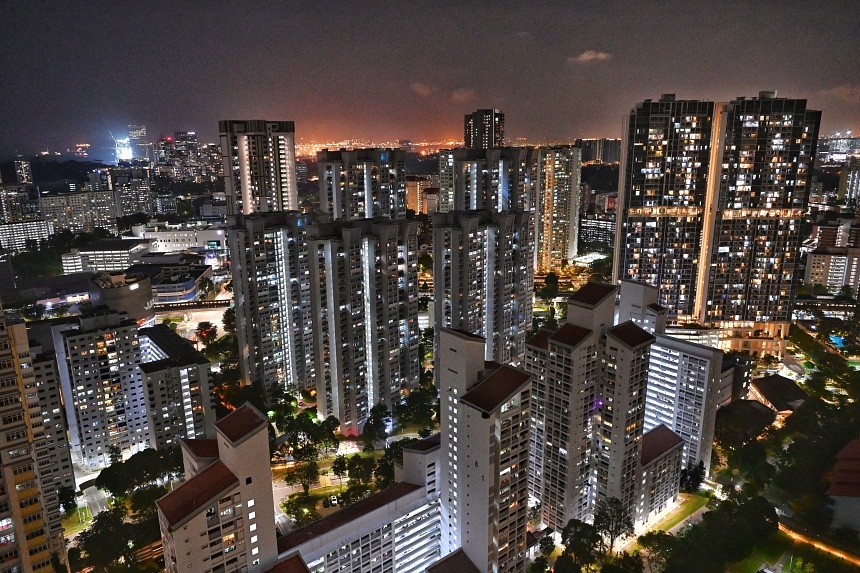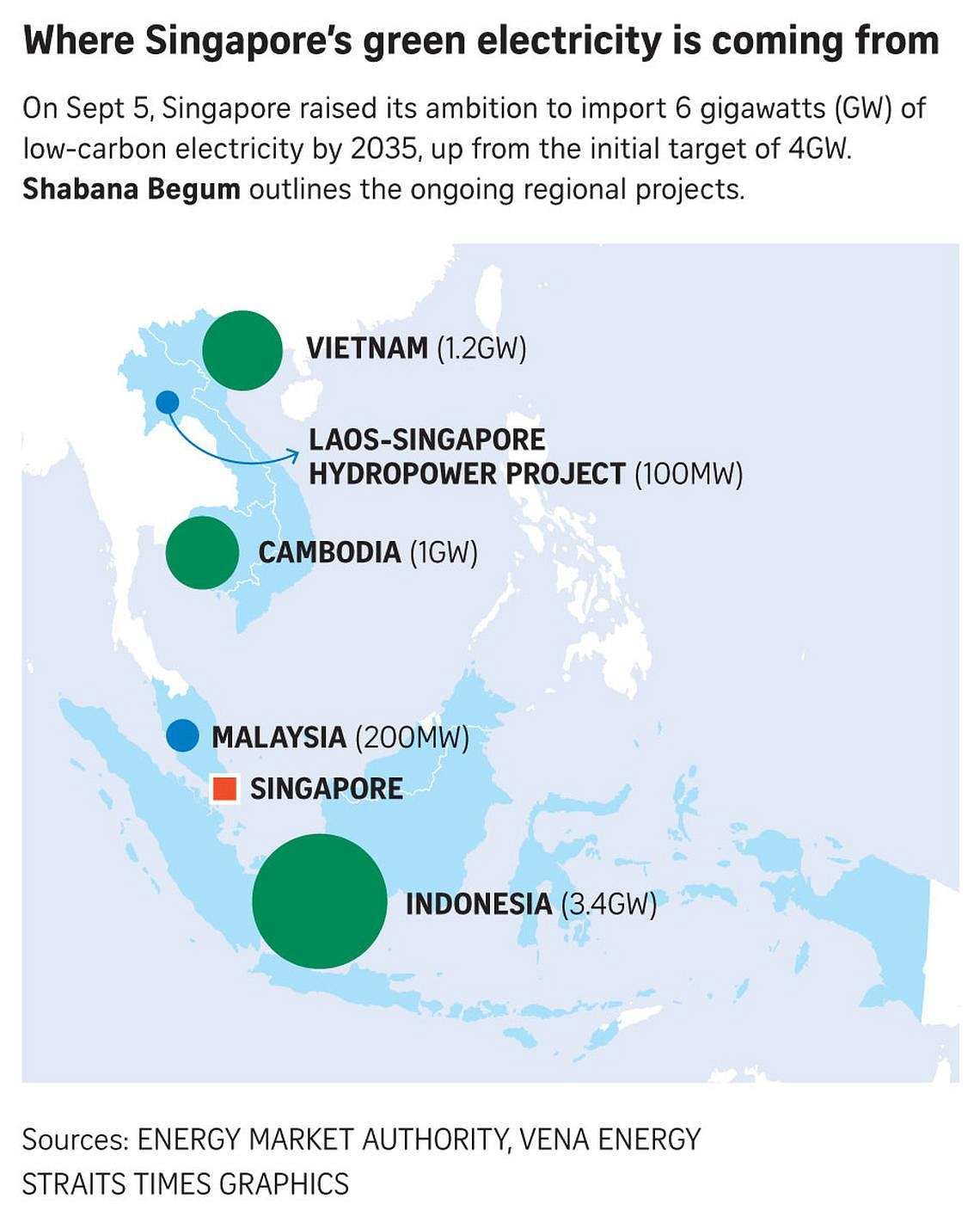Singapore đã tăng cường nỗ lực giảm lượng khí thải carbon của ngành điện, với mục tiêu mới là nhập khẩu 6 gigawatt (GW) điện carbon thấp từ các nước láng giềng vào năm 2035.

Nhập khẩu điện dự kiến sẽ chiếm khoảng một phần ba nhu cầu năng lượng của đất nước vào năm 2035. ẢNH ST: CHONG JUN LIANG
Đây là mức tăng 50% so với mục tiêu trước đó là 4GW, được đặt ra vào năm 2021.
Nhập khẩu điện dự kiến sẽ chiếm khoảng 1/3 nhu cầu năng lượng của đất nước vào năm 2035 và các hoạt động thương mại theo một số hợp đồng nhập khẩu này có thể bắt đầu từ năm 2028, Cơ quan Thị trường Năng lượng (EMA) cho biết hôm 5/9.
Cộng hòa hiện đang phụ thuộc vào khí đốt tự nhiên, một loại nhiên liệu hóa thạch, cho khoảng 95% sản lượng điện. Khoảng 40% lượng khí thải carbon của quốc gia đến từ ngành điện.
EMA cho biết họ quyết định nâng mục tiêu nhập khẩu do "sự quan tâm mạnh mẽ của các bên đáng tin cậy để tham gia vào các dự án nhập khẩu điện và đảm bảo cung cấp đủ để đáp ứng nhu cầu năng lượng trong tương lai của Singapore".
Đến cuối năm 2023, Singapore đang trong giai đoạn thăm dò các thỏa thuận nhập khẩu điện mới với các công ty ở Indonesia, Campuchia và Việt Nam để nhập khẩu 4,2GW điện, vốn đã cao hơn mục tiêu ban đầu.
Giai đoạn đầu tiên đòi hỏi công ty phải nhận được "sự chấp thuận có điều kiện" từ EMA, có nghĩa là cơ quan quản lý đã phát hiện ra rằng đề xuất của dự án là khả thi về mặt kỹ thuật và thương mại. Tại thời điểm này, công ty sẽ bắt đầu khảo sát thêm và nghiên cứu khả thi.
If it can demonstrate its ability to meet the requirements of both the host country and Singapore, EMA will then award it a conditional licence. This is given to projects that have been found to be technically and commercially viable, and are in an advanced developmental stage, the agency said.
The third and final step is when EMA issues importer licences to companies.
At this stage, the companies must obtain the relevant regulatory approvals and secure all the necessary financing for their projects, be it a wind farm or a solar field. The companies can also start construction and commercial work at this point.
On Sept 5, the EMA announced during the Indonesia International Sustainability Forum in Jakarta that it has granted conditional licences for five projects in Indonesia. These firms – which include Pacific Medco Solar Energy and Keppel Energy – are the first to reach the second stage of the electricity import process.
The five firms, which had proposed solar projects, were each awarded conditional approval in September 2023.
EMA said the five companies are targeting to start commercial operations from 2028. The five projects will send 2GW of greener energy to Singapore.
Speaking more about the conditional licences at the Jakarta forum on Sept 5, Second Minister for Trade and Industry Tan See Leng said that what the five firms have achieved is “not a small feat”.
“This actually recognises that these projects are in an advanced developmental stage,” he said. “The conditional licences also signify that these projects have substantially demonstrated the ability to meet the stringent requirements of both Indonesia and Singapore.”
Also at the forum was Senior Minister and Coordinating Minister for National Security Teo Chee Hean, who said that the agreements announced on Sept 5 were the “next step of development” in sustainability collaboration between Singapore and Indonesia.
During the event, EMA also announced that it had granted two more companies in Indonesia “conditional approvals” to import 1.4GW of electricity.
One of the two Indonesian projects to be granted approval on Sept 5 is Singa Renewables, which plans to pipe 1GW of solar energy from Indonesia to Singapore. Singa Renewables is a joint venture between energy giant TotalEnergies and conglomerate RGE.
The other solar project, to be sited on the Riau Islands of Indonesia, is a venture between Shell Eastern Trading and Vena Energy. The project involves solar plants and battery energy storage systems that will produce 0.4GW of electricity for Singapore.
EMA said in a statement that both Singapore and Indonesia are committed to facilitating cross-border trading projects and investments in the development of renewable energy manufacturing industries. Dr Tan upheld the importance of collaboration between countries to ensure successful energy transition in the region.
“The key thing in making this transition a success is interconnectivity,” he said at the event, which was held at the Jakarta Convention Centre.
“The more highly networked, the more connected we are, the more governments can come together (to) establish a very clear, very predictable, transparent framework – both in terms of standards as well as regulation.”
The low-carbon energy from Cambodia and Vietnam is expected to come from mainly solar, hydropower and wind farms.
Singapore’s raised ambitions to import electricity come amid reports of a setback in importing hydropower from Laos, through Thailand and Malaysia.

While the Republic had started importing up to 100MW of hydropower from Laos since 2022 under a trial, Reuters reported in mid-July that the extension of the deal was stuck due to disagreements over how the energy will be transmitted through Thailand and Malaysia.
Singapore has yet to sign deals with Thailand and Malaysia due to disagreements over the quantity of power to be purchased, reported Reuters.
Singapore also has electricity import trials with Malaysia.
In early 2023, it was announced that Singapore will import 100MW of electricity from Malaysia as part of a two-year trial under a joint agreement between YTL PowerSeraya and TNB Genco. The electricity will come from the latter’s gas-fired power plant in Johor. According to EMA, the imports will start in 2024.
In April, Malaysia set up an energy exchange, inviting companies to participate in an auction to supply 100MW of green electricity to Singapore via an existing interconnection between both countries.
In addition to imports, EMA said it will continue to study all decarbonisation pathways for the power sector, including hydrogen, solar, deep geothermal and nuclear energy, as well as carbon capture and storage technologies.
Correction note: An earlier version of the story included details about the Laos-Singapore hydropower project from EMA’s website. EMA has since clarified that it is inaccurate.
Sources of Singapore’s green energy
Indonesia (3.4GW)
Status: A mix of conditional licences and approvals
Five solar projects to export 2GW of greener electricity received conditional licences on Sept 5, with the aim to start operations from 2028.
Two solar projects to import 1.4GW have been granted conditional approvals
Cambodia (1GW)
Status: Conditional approval
Keppel Energy received conditional approval to import hydropower, solar and potentially wind power from Cambodia’s Royal Group Power Company in early 2023.
New subsea cables could transmit electricity over more than 1,000km.
Vietnam (1.2GW)
Status: Conditional approval
From 2033, Singapore will import 1.2GW of low-carbon electricity – primarily generated by wind power.
The electricity will be transmitted through subsea cables.
Laos-Singapore hydropower project (100MW)
Status: Import trial
Started in June 2022, involving import of up to 100 megawatts (MW) of renewable energy via Thailand and Malaysia.
The project appears to have stalled amid disagreements over how the energy will be transmitted through Thailand and Malaysia, and the amount of power to be bought.
Malaysia (200 MW)
Status: Pilot
YTL PowerSeraya will import 100MW of electricity from a gas-fired power plant in Johor over two years starting in 2024.
In April, Malaysia invited companies to participate in an auction to supply 100MW of green electricity to Singapore.
3 steps before transmitting electricity to Singapore
1. Conditional approval: Project proposal found to be technically and commercially viable
2. Conditional licence: Projects are in advanced development stages, and companies can get regulatory approvals
3. Giấy phép nhập khẩu điện: Các công ty phải đảm bảo tất cả các khoản tài chính cần thiết cho các dự án của mình trước khi bắt đầu xây dựng và thương mại
Mời đối tác theo dõi hoạt động của Công ty TNHH Pacific Group.
FanPage: https://www.facebook.com/Pacific-Group
YouTube: https://www.youtube.com/@PacificGroupCoLt






